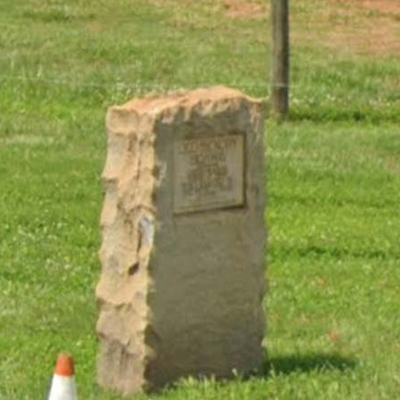
Old Hickory Highway Marker, Raleigh
The Old Hickory Highway marker is a roughhewn square granite block three-feet wide by three-feet high. A smooth recessed rectangle holds the inscription.
OLD HICKORY / HIGHWAY / ERECTED IN LOVING / MEMORY OF THOSE / WHO SERVED IN / WORLD WAR / WILSON CHAPTER OF / WAR MOTHERS OF NORTH CAROLINA
May 13. 1931
35.794790 , -78.706190
View in Geobrowse
“Liquor Question Hotly Debated by War Mothers,” The News And Observer (Raleigh, NC), May 14, 1931
“American War Mothers,” SNAC (Social Networks and Archival Context), snaccooperative.org, (accessed November 3, 2021) Link
“Call Quest,” The Charlotte News (Charlotte, NC), August 4, 1972
“Will Erect Individual Memorials Along “Old Hickory” and “Wildcat” Highways in Memory of Fallen Heroes,” Asheville Citizen-Times (Charlotte, NC), May 17, 1922
“World War Mothers to Honor Memory of War by Appropriate Markers,” The Charlotte Observer (Charlotte, NC), February 16, 1930
Yes
Granite
Wilson Chapter, War Mothers of North Carolina
Four children performed the unveiling, Mary Hackney and Elizabeth Schaum of Wilson and Novella Capps and Elizabeth Bell of Raleigh. The marker was presented by Mrs. C.E. Blount and accepted by Mr. C. A. Gosney on behalf of North Carolina service men.
Records of the American War Mothers state that the organization “was founded in response to federal officials impressed with and grateful for the Food Conservation and War Relief Work carried on by mothers of servicemen and women during World War I.” with membership “limited to U.S. women whose children served in the Armed Forces. On September 29, 1917, these officials requested that a permanent War Mothers organization be established.” By Armistice Day, November 11, 1918, two-thirds of the states were organized into chapters. On February 24, 1925, Congress granted the American War Mothers a National Charter. Their purpose was to engage in patriotic works and assist men and women who served and were wounded in American conflicts.
Miss May F. Jones of Asheville is credited with the idea of commemorating the two major routes stretching across North Carolina from the mountains to the coast for those who served during World War One. With the backing of the Asheville Chamber of Commerce and the North Carolina Division of American War Mothers, the legislature designated them in 1921 as “memorials to the heroism and valor of all North Carolinians who answered the call...” to serve during World War One. The “Central” Highway (Hwy. 10) was designated as the “Old Hickory Highway” after the 30th Infantry Division. This division’s name honored Andrew Jackson who received the nickname as a reflection of his tenacious and unyielding nature. Men from this division came from North Carolina, South Carolina, Georgia and Tennessee. The “Wilmington-Charlotte-Asheville” Highway (Hwy. 20) was designated as the “Wildcat” Highway after the 81st Infantry Division. During World War One the 81st Infantry Division, nicknamed the “Wildcat” Division, was stationed at Ft. Jackson in Columbia, South Carolina. Most of the men in this division came from North Carolina and South Carolina.
The “Old Hickory” Highway began at Paint Rock on the North Carolina-Tennessee line and passed through Asheville, Statesville, Greensboro, Raleigh, Goldsboro and ending at Beaufort, very roughly the course of portions of I-40 and US Highway 70. The “Wildcat” Highway began at the North Carolina-Georgia line passing through Murphy and also on to Asheville, then Shelby, Lumberton and to Wilmington. The route closely follows the path of old US Highway 74. In 1922 much of the route was over unpaved roads and the North Carolina Highway Commission committed to marking these routes as the roads were improved. The efforts languished leaving the War Mothers markers as the only visible memory of the two highways.
Wildcat Division markers were placed in Lake Lure, Gastonia, Charlotte (two), Wadesboro and Wilmington. Old Hickory Division markers were placed in Statesville, Salisbury, Raleigh (two), and Craven County. A marker with a bronze tablet commemorating both divisions was placed at the intersection of the two highways near Asheville.
The marker is located at the northeast corner of Blue Ridge Road and Hillsboro Street across from the NC State Fairground in Raleigh, NC.
The marker stands on the grass at the intersection of two busy roads.
 Know anything else about this monument that isn't mentioned here? If you have additional information on
this or any other monument in our collection fill out the form at the Contact Us link in the footer. Thank you.
Know anything else about this monument that isn't mentioned here? If you have additional information on
this or any other monument in our collection fill out the form at the Contact Us link in the footer. Thank you.

